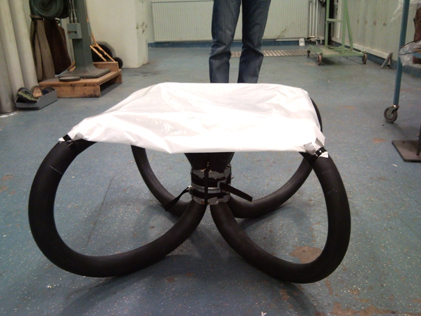Students to fly rocket probe from Kiruna in 2010

Six students from the Department of Space and Plasma Physics have been selected by ESA’s REXUS programme to fly a rocket probe from Kiruna. Now they must undertake a year’s training in space quality, design review and construction of the experiment.
The six students presented their proposal at ESA’s technical centre in Holland - ESTEEC - at a workshop on 3-5 February. After which their proposal was selected as one of the best technical solutions for flying a rocket probe from Kiruna. One of the special features of their proposal is the umbrella-like inflatable design structure which protects the probe and helps stabilise it during descent so that it can be reused.
The aim of the KTH-based project is to design, build and validate the prototype of a miniaturised measuring platform that can be ejected from the rocket probe and collect data in an on-board memory. The LAPLander design includes air-braking, impact protection and recovery systems, along with the study of flight characteristics to evaluate payload performance.
Constructed for space
In March the students will participate in a student training week at the Deutsches Zentrum fur Luft- und Raumfart (DLR) – German Space Agency – where they will learn how to build space quality constructions. DLR will also make a preliminary design review (PDR) of the project. At this review the students will present an outline plan describing what the different parts of the rocket look like and how they will interact.
Then in June the Critical Design Review (CDR) will be held. This requires a more detailed description of the project. At this point they must have resolved any major problems and present a compact, well-defined project. The experimental probe will be built during the summer and autumn of 2009.
Project Manager:
Torbjörn Sundberg, PhD student, Space and Plasma Physics, KTH
Students in the project and their areas of responsibility:
- Joakim Sandström (Electrical Engineering, 3rd year), Electronics and software
- Malin Gustafsson (Electrical Engineering, 3rd year), Electronics and software
- Oliver Neuner (Master’s Programme in Electrophysics), Electronics and software
- Christian Westlund (Aerospace Engineering), Mechanics and Design
- Matias Wartelski (Aerospace Engineering, Double degree student), Mechanics and Design
- Li Xin (Master’s programme in Aerospace), Aerodynamic issues and modelling
About REXUS
ESA’s REXUS Programme in the form of bilateral German-Swedish cooperation offers students opportunities to fly their own experimental probes from Kiruna, northern Sweden. REXUS is a cooperative programme implemented by the Swedish Space Corporation (SSC) together with Deutches Zentrum für Luft- und Raumfahrt (DLR) and the European Space Agency (ESA), and is financed by the Swedish National Space Board and DLR. The basic idea behind REXUS is to provide an experimental space platform for students.
Read more about the LAPLander project.
LAPLander project